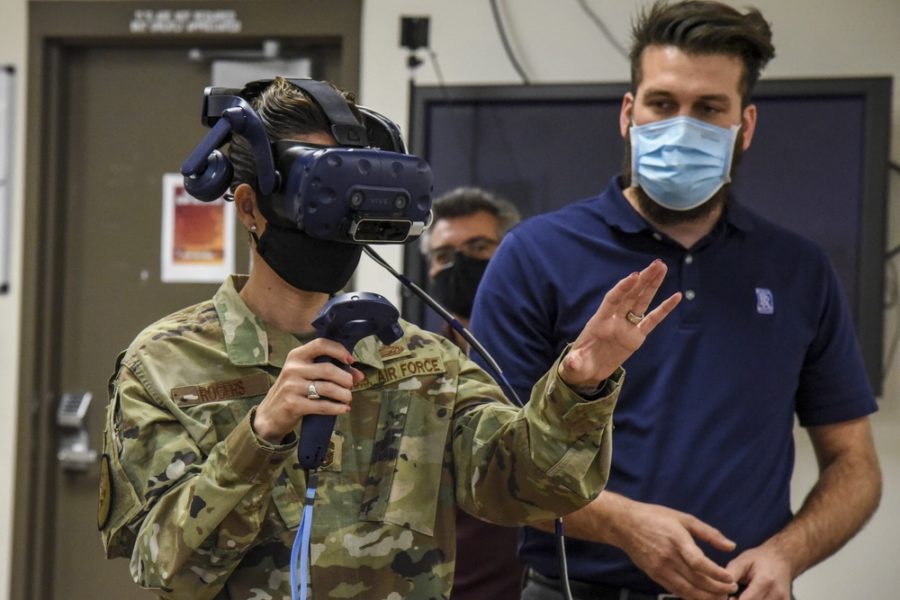In many ways, the Air Force has embraced new technologies such as augmented and virtual reality for the service’s training in recent years like never before—pilots, maintainers, even commanders dealing with suicidal Airmen have started to participate in programs designed to engage them in new ways.
But the service can move even faster and more aggressively to adopt these technologies, advocates say—and lawmakers have agreed, inserting language into the 2023 National Defense Authorization Act that would seek to prod the Air Force’s efforts forward.
In the committee report accompanying its version of the NDAA, the House Armed Services Committee commended the Air Force’s “progress in deploying digital training infrastructure” but expressed concern that the service “may not have sufficient plans in place to integrate digital training infrastructure into its training organizations and commands at a speed that aligns with the pace of software development.”
To address that concern, the report calls for the Secretary of the Air Force to brief Congress by March 2023 on a “service-wide plan to transition digital training infrastructure into the appropriate Air Force organizations as soon as technical readiness will allow.”
Such directive report language is not legally binding like language included in the bill itself, but Pentagon officials typically “regard it as a congressional mandate and respond accordingly,” according to the Congressional Research Service.
In particular, the committee is asking the Secretary to include details on future support and sustainment plans for digital training infrastructure; plans to include immersive tech such as virtual, mixed, and augmented reality; and ways to unify efforts across the Air Force.
Already, Air Education and Training Command uses tech company Dynepic to maintain a platform called MOTAR that keeps track of disparate augmented and virtual reality training programs across the command and maintains a digital training record for individual Airmen.
In running that platform, Dynepic has seen support from lower-level Airmen and high-level leadership who want to embrace that kind of training even more, CEO Krissa Watry told Air Force Magazine. But hurdles persist—bureaucracy, skeptics, and a lack of any single organization to lead the charge in pushing it forward.
“Any time you have new technology, and it’s moving at a rapid pace, you have folks that just aren’t quite up to speed yet,” Watry said. “And so maybe they have their projects and they think they’re the latest and greatest. But one thing with the agile software mindset is you have to be willing to sometimes scrap stuff and move forward with a new way or a new vision. And I think that’s one of the key areas, is you need a flexible infrastructure, stuff that allows for technology to be rapidly tested, fielded, and even swapped out with new stuff.”
Tech companies have frequently bemoaned the Pentagon’s acquisition process, which they say is outdated and moves too slowly for rapidly evolving software, and many smaller companies have fallen into the “Valley of Death,” where new innovative technologies are demonstrated but never become programs of record.
Dynepic wants to help small businesses leveraging VR, AR, and other digital training to cross that valley, Watry said.
The company also wants help organizing a system that at the moment lacks a top-down authority. MOTAR is an Air Education and Training Command requirement, but other Air Force major commands don’t have the same access, even as they conduct operational training, too.
“We’ve tried to be that glue, through our conversations and meetings, to pull in the other operational commands, because all the Airmen want to use it,” Watry said. “But then they’re like, ‘Well, is this an enterprise capability?’ Is this something that—am I having to pay for it on a unit level, which is the way it currently works? Or is this going to be an enterprise solution, and then we have to pay for the custom stuff that our command needs? When you’re talking about ACC and Global Strike and AMC and all those other commands and AFSOC, I guess they’re looking for unity of effort. They would like unity of effort, but they’re still just a single command, and they’re like, who’s in charge?”
Dynepic would like to see a program office set up to oversee and organize such virtual training, Watry said. Looking to push for more coordination, and for faster and more widespread adoption across the board, Dynepic’s leaders met with members of the HASC readiness subcommittee during the NDAA-drafting process to push for directive report language.
“We believe that [training is] highly effective, not only for technical training—your maintenance training, air traffic control, pilot training—but for even just [emotional intelligence]-style training, or a lot of the other areas of use around even just, how can they maybe escape from the environment they’re in and be able to relax better? So there’s a number of different pathways for extended reality to be used in the U.S. military that will make Airmen better. That’s the goal.”
In those meetings, they got positive responses, said consultant Ryan Crumpler, a former HASC staff member.
“When I was on the committee as a professional staffer, this is something that we focused on, which is how to get more training bang for your buck,” Crumpler said. “And the only way to do that is through kind of novel approaches. You just can’t buy enough flight hours or tank miles or full spectrum training miles or whatever your measure of efficacy is. So I think staff and members were receptive.”
It also helps, Crumpler said, that such training could be adapted or adopted from commercial tech companies, an increasing area of emphasis for top lawmakers.
“It nests nicely with the broader push that Congress has made to go more commercial … instead of waiting years and billions of dollars for a bespoke system that’s built through the traditional acquisition process,” Crumpler said.

